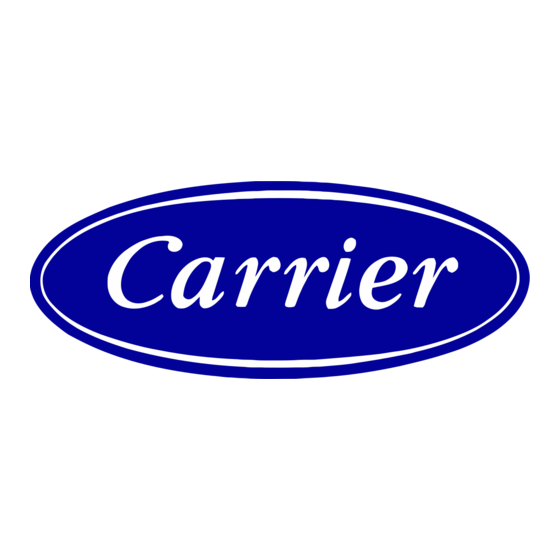Table of Contents
Advertisement
Quick Links
HEATING A COOLING
19QA
Refrigerant Management System
Installation, Operating and Maintenance
Instructions
For use with Centrifugal Liguid Chillers
SAFETY CONSIDERATIONS
Centrifugal liquid chillers are designed to provide safe and re¬
liable service when operated within design specifications. When
operating this equipment, use good judgement and safety pre¬
cautions to avoid damage to equipment and property or injury
to personnel.
Be sure you understand and follow the procedures and safety
precautions contained in the machine instructions as well as
those listed in this guide.
A DANGER
DO NOT VENT lefrigerant relief valves within a building Outlet fioin
rupture disc or relief valve must be vented outdoois in accordance with the
latest edition of ANSI/ASHRAE 15 (Safety Code for Mechanical Refrig¬
eration). The accumulation of refrigerant in an enclosed space can dis¬
place oxygen and cause asphyxiation
PROVIDE adequate ventilation in accordance with ANSI/ASHRAE 15,
especially for enclosed and low o vet head spaces. Inhalation of high con¬
centrations of vapor is hatmful and may cause heart irregularities, uncon¬
sciousness, oi death Intentional misuse can be fatal Vapor is heavier
than ail and reduces the amount of oxygen available for breathing. Piod-
uct causes eye and skin initation. Decomposition products are hazaidous
DO NOT USE OXYGEN to purge lines or to pressurize a machine for any
purpose. Oxygen gas leacts violently with oil, grease and other common
substances.
NEVER EXCEED specified test pressures. VERIFY the allowable test
pressure by checking the instruction liteiature and the design pressures on
the equipment nameplate.
DO NOT VALVE OFF any safety device
BE SURE that all piessuie lelief devices are propeily installed and func¬
tioning before operating any machine.
A WARNING
DO NOT WELD OR FLAME CUT any lefrigerant line or vessel until all
refrigeiant (liquid and vapor) has been removed from chiller. Traces of
vapor should be displaced with dry air or nitrogen and the work area should
be well ventilated. Refrigerant in contact with an open flame produces
toxic gases.
DO NOT USE eyebolts oi eyebolt holes to lig machine sections or the
entire assembly.
DO NOT wotk on high-voltage equipment unless you are a qualified
electrician.
DO NOT WORK ON electiical components, including control panels,
switehes, starters or oil heater until you are sure ALL POWER IS OFF
and no residual voltage can leak fiom capacitors or solid-state
components.
LOCK OPEN AND TAG electrical circuits during servicing. IF WORK
IS INTERRUPTED, confirm that all circuits are de-energized before re¬
suming work.
DO NOT syphon lefrigerant by mouth
AVOID SPILLING liquid refrigerant on skin or getting it into the eyes.
USE SAFETY GOGGLES Wash any spills from the skin with soap and
water If any enters the eyes, IMMEDIATELY FLUSH EYES with water
and consult a physician.'
NEVER APPLY an open flame oi live steam to a refrigeiant cylinder
Dangerous overpressure can result When necessary to heat refrigerant,
use only warm (110 F/43 C) water
DO NOT REUSE disposable (nonreturnable) cylinders nor attempt to le-
fill them It is DANGEROUS AND ILLEGAL When cylindei is emp¬
tied, evacuate remaining gas piessure, loosen the collar and unscrew and
discaid the valve stem. DO NOT INCINERATE
CHECK THE REFRIGERANT TYPE before charging machine. High-
pressuie refrigerant in a low-pressuie machine can cause vessels to rupture
if the lelief devices cannot handle the refilgeiant volume
Operation of this equipment with refrigerants other than those cited heiein
should comply with ANSFASHRAE-15 (latest edition) Contact Canier
for further information on use of this machine with other low-pressure
refrigerants.
DO NOT ATTEMPT TO REMOVE fittings, coveis, etc while machine
is under piessure or while machine is lunning. Be sure pressure is at zero
psig before breaking any refiigerant connection.
CAREFULLY INSPECT all relief valves, rupture discs and other relief
devices AT LEAST ONCE A YEAR If machine operates in a corrosive
atmospheie, inspect the devices at more frequent intervals
DO NOT ATTEMPT TO REPAIR OR RECONDITION any relief valve
when corrosion or build-up of foreign material (rust, dirt, scale, etc ) is
found within the valve body or mechanism Replace the valve.
DO NOT install relief devices in series or backwards
USE CARE when working near or in line with a compressed spring. Sud¬
den release of the spring can cause it and objects in its path to act as
projectiles.
A CAUTION
DO NOT STEP on refrigerant lines. Bioken lines can whip about and
cause personal injury
DO NOT climb over a machine Use platfoim, catwalk or staging Follow
safe practices when using ladders
USE MECHANICAL EQUIPMENT (crane, hoist, etc.) to lift or move
inspection covers or other heavy components Even if components ate light,
use such equipment when theie is a risk of slipping or losing youi balance
BE AWARE that certain automatic start atiangements CAN ENGAGE
THE STARTER Open the disconnect ahead of the starter in addition to
shutting off the machine or pump.
USE only repair or leplacement parts that meet the code requirements of
the original equipment
DO NOT VENT OR DRAIN water boxes containing industrial brines, liq¬
uid, gases or semisolids without permission of your fi'ocess Control Group
DO NOT LOOSEN water box cover bolts until the water box has been
completely drained.
DOUBLE-CHECK that coupling nut wrenches, dial indicators or other
items have been removed before rotating any shafts
DO NOT LOOSEN a packing gland nut before checking that the nut has
a positive thread engagement.
PERIODICALLY INSPECT all valves, fittings and piping for conosion,
rust, leaks or damage
PROVIDE A DRAIN connection in the vent line near each pressure relief
device to prevent a build-up of condensate or rain water.
Manufacturer reserves the right to discontinue, or change at any time, specifications or designs without notice and without incurring obligations.
Book|2 12
PC 211
Catalog No 531-932
Printed in U S.A
Form 19QA-1Si
Pg 1
1-90
Replaces: New
Tab 5a 5d
Advertisement
Table of Contents











Need help?
Do you have a question about the 19QA and is the answer not in the manual?
Questions and answers